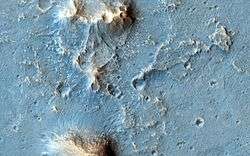Oxia Planum
Oxia Planum is a plain located on Mars (near 18.275°N 335.368°E)[1] that has been chosen as a preferred landing location for the ExoMars rover,[2][3][4] with an elevation more than 3000 metres below the Martian mean.[5]
 | |
| Location | Oxia Palus quadrangle |
|---|---|
| Coordinates | 18.275°N 335.368°E |
Overview
Oxia Planum contains one of the largest exposures of clay-bearing rocks and are around 3.9 billion years old.[6] The site is iron-magnesium rich clays, indicating that water once played a role here. The site sits in an area of valley systems with the exposed rocks exhibiting different compositions, indicating a variety of deposition and wetting environments.
Clay accumulation underneath the remnants of a fan or delta near the outlet of Coogoon Vallis may offer preservation for biosignatures against the planet's harsh radiation and oxidation environment.[6][7][8]


See also
References
- Bridges, John (July 1, 2015). "Clay-Rich Terrain in Oxia Planum: A Proposed ExoMars Landing Site". Arizona University. Retrieved October 21, 2015.
- "Oxia Planum Favoured for ExoMars Surface Mission". www.esa.int. European Space Agency. November 9, 2018. Retrieved June 25, 2019.
- Amos, Jonathan (October 21, 2015). "ExoMars rover: Landing preference is for Oxia Planum". BBC News. Retrieved October 22, 2015.
- Atkinson, Nancy (October 21, 2015). "Scientists Want ExoMars Rover to Land at Oxia Planum". Universe Today. Retrieved October 22, 2015.
- ESA mission updates. Emily Lakdawalla; 5 November 2015.
- Durnham, R. (October 21, 2015). "ExoMars 2018 rover heading for Oxia Planum". Red Planet Report. Retrieved October 22, 2015.
- Thollot, P.; Quantin, C. (May 14, 2014). "Oxia Planum, landing site for Mars 2020" (PDF). Universite de Lyon, France. Retrieved October 22, 2015.
- Staff (October 1, 2014). "Possible Future Mars Landing Site in Oxia Planum - High Resolution Imaging Science Experiment". The University of Arizona. Retrieved October 21, 2015.
External links
- Google Mars zoomable map – centered on the Oxia area
- High resolution images of the Oxia Planum
.jpg)